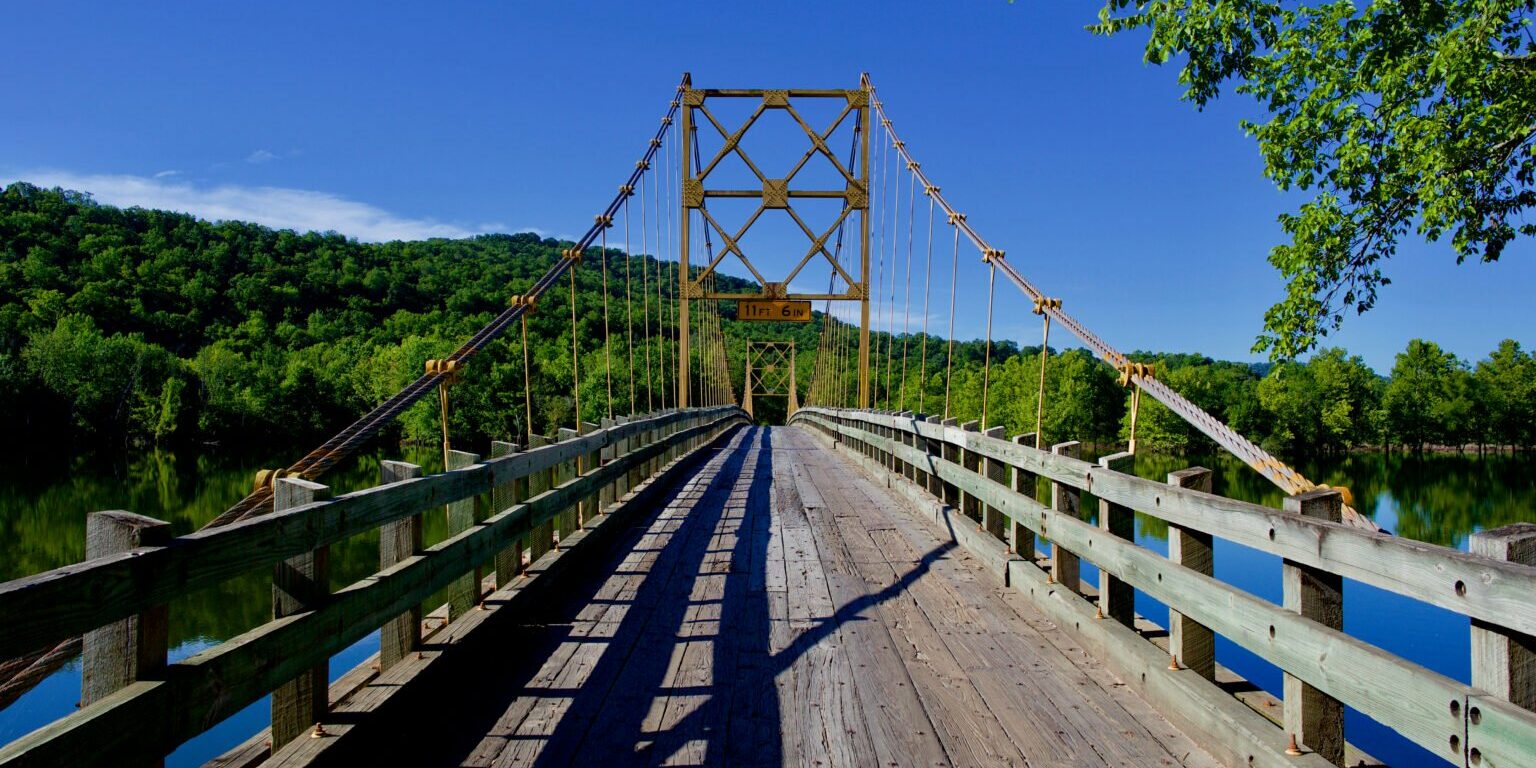The Grandeur of the Ozarks
The Ozarks region is known for its stunning natural beauty, and one of the best ways to experience it is by crossing its scenic bridges. With towering bluffs, winding rivers, and lush forests, the Ozarks offer a feast for the eyes at every turn.
Whether you’re a seasoned hiker or a leisurely sightseer, the Ozarks’ bridges offer a unique perspective on the region’s beauty. From historic covered bridges to modern steel structures, each bridge has its own story to tell.
One of the most iconic bridges in the Ozarks is the Beaver Bridge, also known as the Little Golden Gate. This historic one-lane suspension bridge spans the White River and offers breathtaking views of the surrounding hills. Its bright yellow color and unique design make it a favorite among photographers and tourists alike.
Another must-see bridge in the Ozarks is the Big Piney Creek Bridge in Pope County, Arkansas. This steel truss bridge spans the Big Piney Creek and offers stunning views of the rugged Ozark Mountains. Its location in the heart of the Ozark National Forest makes it a popular spot for hiking, fishing, and camping.
For those looking for a more leisurely experience, the Redings Mill Bridge in Joplin, Missouri is a great option. This historic covered bridge spans Shoal Creek and is surrounded by picturesque farmland and rolling hills. Its peaceful setting and rustic charm make it a favorite among locals and visitors alike.
No matter which bridge you choose to cross, the Ozarks’ natural grandeur is sure to leave a lasting impression. So grab your camera, pack a picnic, and hit the road to explore the beauty of this unique region.
Historical Significance of Bridges in the Ozarks
Bridges have played a significant role in the development of the Ozarks region, connecting communities, facilitating trade, and enabling travel across the rugged terrain. The early bridges were simple wooden structures built over rivers and streams, but as the population grew, so did the need for more durable and larger bridges.
During the late 19th and early 20th centuries, the Ozarks saw a boom in bridge construction, with many of the bridges built during this period still standing today. These bridges are not only a testament to the engineering skills of the time but also serve as a reminder of the region’s industrial and economic history.
One of the most significant bridges in the Ozarks is the Old Chain of Rocks Bridge, which spans the Mississippi River near St. Louis. The bridge was built in 1929 and served as a vital transportation link for decades before it was decommissioned in the 1960s. Today, the bridge is a popular tourist attraction and a symbol of the region’s industrial heritage.
Another notable bridge is the Bagnell Dam Bridge, which crosses the Osage River in central Missouri. The bridge was built in 1929 as part of the construction of the Bagnell Dam, which created the Lake of the Ozarks. The bridge is still in use today, connecting the communities on either side of the lake.
Other significant bridges in the Ozarks include the Eads Bridge in St. Louis, the Walnut Street Bridge in Springfield, and the Arkansas-Missouri Railroad Bridge in Carthage.
Overall, the bridges in the Ozarks are not only important transportation links but also serve as a reminder of the region’s rich history and heritage.
The Beaver Bridge
Located in Carroll County, Arkansas, the Beaver Bridge is one of the most picturesque bridges in the Ozarks. Built in 1949, it spans across the White River and is also known as the “Little Golden Gate Bridge”.
Unique Features
What sets the Beaver Bridge apart from other bridges in the area is its unique design. The bridge is a single-lane suspension bridge, which means that it is suspended from cables anchored to towers on either side of the river. The wooden deck and guardrails give the bridge a rustic feel that is in keeping with the surrounding natural beauty.
Visitor Experience
The Beaver Bridge is a popular attraction for tourists and locals alike. Visitors can drive across the bridge and enjoy stunning views of the White River and the surrounding Ozark Mountains. The bridge also provides access to the nearby Beaver Lake, which is a popular destination for fishing, boating, and other water activities.
For those who prefer to explore on foot, there is a pedestrian walkway that offers a unique perspective of the bridge and the river below. Visitors can also take a short hike to the nearby overlook, which provides panoramic views of the area.
Overall, the Beaver Bridge is a must-visit destination for anyone traveling through the Ozarks. Its unique design and stunning views make it a true gem of the region.
The Cotter Bridge
The Cotter Bridge, also known as the R.M. Ruthven Bridge, is a historic bridge located in the Ozarks region of Arkansas. It spans the White River and is a popular destination for tourists and locals alike. Here are some of the key features that make the Cotter Bridge one of the most scenic bridges in the Ozarks.
Architectural Details
The Cotter Bridge is a steel truss bridge that was built in 1930. It was designed by the Missouri State Highway Department and was constructed by the Kansas City Bridge Company. The bridge is 1,642 feet long and has a width of 24 feet. It features a unique design with a curved roadway that follows the contours of the river.
One of the most striking features of the Cotter Bridge is its color. The bridge is painted bright blue, which provides a beautiful contrast against the green trees and blue water of the White River. The bridge’s steel trusses and cross-bracing are also painted blue, which gives the bridge a cohesive and eye-catching appearance.
Scenic Surroundings
The Cotter Bridge is located in a beautiful natural setting. The White River is known for its clear water and scenic beauty, and the area around the bridge is no exception. The bridge provides stunning views of the river and the surrounding hills and forests.
There are also several parks and recreational areas near the Cotter Bridge that offer opportunities for hiking, fishing, and other outdoor activities. The Cotter Trout Dock is located just downstream from the bridge and is a popular spot for fishing enthusiasts. The Cotter Big Spring Park is also nearby and features a natural spring that flows into the White River.
Overall, the Cotter Bridge is a must-see destination for anyone visiting the Ozarks region. Its unique design and stunning surroundings make it one of the most scenic bridges in the area.
The Swinging Bridge
The Swinging Bridge is one of the most popular bridges in the Ozarks due to its unique design and scenic location. Located in Branson, Missouri, this bridge is a must-visit for anyone looking to experience the beauty of the Ozarks.
Engineering Marvel
The Swinging Bridge was built in 1912 and is considered an engineering marvel. The bridge spans 200 feet and is suspended 60 feet above the water. It was originally built for cars, but now it’s only open to pedestrians. The bridge is made of steel cables and wooden planks, which give it a unique look and feel.
Attractions Nearby
The Swinging Bridge is located in the heart of Branson, Missouri, which means there are plenty of attractions nearby. Visitors can take a stroll along the Branson Landing Boardwalk or enjoy a meal at one of the many restaurants in the area. There are also several shops and boutiques where visitors can find unique souvenirs to take home.
Overall, the Swinging Bridge is a must-visit for anyone looking to experience the beauty of the Ozarks. Its unique design and scenic location make it one of the most popular bridges in the area.
The Ozark Mill Bridge
The Ozark Mill Bridge is one of the most iconic bridges in the Ozarks. It is a historic landmark that has been standing since 1882. The bridge is located in Ozark, Missouri, and spans over the Finley River. Many people come to the Ozark Mill Bridge to take in the breathtaking views of the surrounding area.
Historical Context
The Ozark Mill Bridge was originally built in 1882 by the King Iron Bridge Company. It was designed to serve as a transportation route for the Ozark Mill, which was a major source of commerce in the area. The bridge was constructed using wrought iron and steel, and it was one of the first bridges of its kind in the Ozarks.
Over the years, the Ozark Mill Bridge has undergone several renovations and repairs. In 1992, the bridge was added to the National Register of Historic Places, recognizing its significance in the history of the Ozarks.
Scenic Highlights
The Ozark Mill Bridge is a popular spot for photography and sightseeing. The bridge offers stunning views of the Finley River, which is known for its clear blue-green waters. Visitors can also take in the picturesque views of the surrounding forests and hills.
One of the best times to visit the Ozark Mill Bridge is during the fall season. The surrounding trees turn vibrant shades of red, orange, and yellow, creating a stunning backdrop for photos. Visitors can also enjoy a leisurely walk across the bridge, taking in the fresh air and tranquil atmosphere.
Overall, the Ozark Mill Bridge is a must-visit destination for anyone traveling through the Ozarks. Its rich history and scenic beauty make it a unique and unforgettable experience for all who visit.
Devil’s Elbow Bridge
The Devil’s Elbow Bridge is one of the most picturesque bridges in the Ozarks. It is located in Pulaski County, Missouri, and spans the Big Piney River. The bridge was originally built in 1923 and was reconstructed in 2003 to preserve its historical significance.
Design Aspects
The Devil’s Elbow Bridge is a truss bridge that is 589 feet long and 23 feet wide. It has a unique design that features a series of arches that create a beautiful and elegant appearance. The bridge is made of steel and concrete, and it has a weight limit of 15 tons.
Natural Beauty
The Devil’s Elbow Bridge is surrounded by stunning natural beauty. The Big Piney River flows beneath the bridge, and the surrounding hills and trees create a breathtaking backdrop. Visitors can enjoy hiking trails, fishing, and camping in the nearby areas.
The bridge is also a popular spot for photography and sightseeing. The best time to visit is during the fall when the leaves are changing colors, and the scenery is at its most beautiful.
Overall, the Devil’s Elbow Bridge is a must-see attraction for anyone visiting the Ozarks. Its unique design and natural beauty make it a popular destination for tourists and locals alike.
The Big Piney River Bridge
The Big Piney River Bridge is one of the most picturesque bridges in the Ozarks. It is located in the heart of the Mark Twain National Forest and spans the Big Piney River.
Structural Elements
The bridge was built in 1933 and is a single-lane, steel truss bridge. It is 180 feet long and 25 feet wide, making it one of the longer bridges in the Ozarks. The bridge is supported by two concrete abutments and a single pier in the middle of the river.
Panoramic Views
The Big Piney River Bridge offers stunning views of the surrounding forest and the Big Piney River. From the bridge, visitors can see the rolling hills and the vibrant greenery that make the Ozarks so beautiful. The bridge is also a popular spot for fishing and swimming, as the river is known for its clear water and abundant fish.
Whether you are a nature enthusiast or simply looking for a beautiful drive, the Big Piney River Bridge is a must-see destination in the Ozarks.
Frequently Asked Questions
What are the Top Scenic Bridges to Visit in the Ozarks?
The Ozarks are home to many beautiful bridges, but some of the most scenic ones include the Big Piney Creek Bridge, the Steel Creek Bridge, the Bagnell Dam Bridge, and the Beaver Bridge. Each of these bridges offers stunning views of the surrounding landscape.
What is the Name of the Most Famous Bridge in Missouri?
The most famous bridge in Missouri is the Gateway Arch Bridge, also known as the “The New Mississippi River Bridge”. This bridge connects St. Louis, Missouri to Illinois and provides breathtaking views of the Mississippi River.
How Many Covered Bridges are in Missouri?
There are currently four covered bridges in Missouri: the Locust Creek Covered Bridge, the Union Covered Bridge, the Burfordville Covered Bridge, and the McBaine Covered Bridge. These bridges are all historic landmarks and offer a unique glimpse into Missouri’s past.
Which Bridges in Missouri Cross the Mississippi River?
There are two bridges in Missouri that cross the Mississippi River: the Eads Bridge and the Gateway Arch Bridge. The Eads Bridge is a historic bridge that was built in 1874 and is now used for trains. The Gateway Arch Bridge is a modern bridge that was completed in 2014 and is used for cars and pedestrians.
What is the Highest Bridge in Arkansas?
The highest bridge in Arkansas is the Big Dam Bridge, which spans the Arkansas River and connects Little Rock and North Little Rock. This bridge is 4,226 feet long and stands 90 feet above the river.
Where Can I Find a Swinging Bridge to Visit in the Ozarks?
One of the most popular swinging bridges in the Ozarks is the Swinging Bridge in Branson, Missouri. This bridge is located in the historic downtown area and offers stunning views of Lake Taneycomo. Another swinging bridge worth visiting is the Redings Mill Bridge in Joplin, Missouri, which is also a historic landmark.







